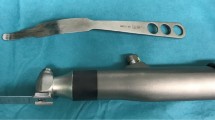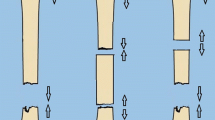Abstract
Purpose
The purpose of corrective osteotomies in posttraumatic and congenital deformities is anatomic limb reconstruction and joint preservation. The aim of the present study was to analyse intra- and perioperative complications of osteotomies in the lower limb.
Methods
One thousand and three unselected and prospectively registered osteotomies of the long bones of the lower limb, performed between 1995 and 2013, were analysed. In 435 women and 568 men (mean age 39.8 years), 478 correction osteotomies were performed femoral and 525 tibial; 696 osteotomies were performed using the oscillating saw, 42 using the Gigli saw and 265 using drill hole/chisel osteoclasis. A total of 869 deformities were corrected in the acute setting and 134 were corrected continuously via callotaxis.
Results
Seventeen (1.7%) major complications requiring revision surgeries were detected: 4 arterial injuries, 2 haematomas, 4 compartment syndromes and 7 deep wound infections. All vascular injuries 4 (0.7%) occurred in osteotomies around the knee (n = 563). Nineteen (1.9%) minor complications could be managed by conservative means: 3 (0.3%) deep vein thromboses and 16 (1.6%) superficial wound infections. No osteomyelitis, pulmonary embolism or death occurred. Gigli saw osteotomy was stained by a higher infection rate. In male patients (p = 0.02), posttraumatic deformities (ns) and continuous procedures (p = 0.025) have a higher risk of superficial infections. No further risks were detected for age, weight, smoking habit and anatomic level of surgery.
Conclusion
Osteotomies around the knee show a very low complication rate. Less aggressive oscillating saws, saw blades and drills are recommended. Vascular injuries, compartment syndromes and deep infections are limb-threatening emergencies demanding fast and determined interventions.
Level of evidence
Prospective cohort study, Level III.

Similar content being viewed by others
References
Amendola A, Bonasia DE (2010) Results of high tibial osteotomy: review of the literature. Int Orthop 34:155–160
Anagnostakos K, Mosser P, Kohn D (2013) Infections after high tibial osteotomy. Knee Surg Sports Traumatol Arthrosc 21:161–169
Bernhoff K, Rudstrom H, Gedeborg R, Bjorck M (2013) Popliteal artery injury during knee replacement: a population-based nationwide study. Bone Joint J 95B:1645–1649
Bisicchia S, Rosso F, Pizzimenti MA, Rungprai C, Goetz JE, Amendola A (2015) Injury risk to extraosseous knee vasculature during osteotomies: a cadaveric study with CT and dissection analysis. Clin Orthop Relat Res 473:1030–1039
Darnis A, Villa V, Debette C, Lustig S, Servien E, Neyret P (2014) Vascular injuries during closing-wedge high tibial osteotomy: a cadaveric angiographic study. Orthop Traumatol Surg Res 100:891–894
Dua A, Zepeda R, Hernanez FC, Igbadumhe AA, Desai SS (2015) The national incidence of iatrogenic popliteal artery injury during total knee replacement. Vascular. 23(5):455–458
Fadel M, Hosny G (2005) The Taylor spatial frame for deformity correction in the lower limbs. Int Orthop 29:125–129
Flierl S, Sabo D, Hornig K, Perlick L (1996) Open wedge high tibial osteotomy using fractioned drill osteotomy: a surgical modification that lowers the complication rate. Knee Surg Sports Traumatol Arthrosc 4:149–153
Hui C, Salmon LJ, Kok A, Williams HA, Hockers N, van der Tempel WM, Chana R, Pinczewski LA (2011) Long-term survival of high tibial osteotomy for medial compartment osteoarthritis of the knee. Am J Sports Med 39:64–70
Kim J, Allaire R, Harner CD (2010) Vascular safety during high tibial osteotomy: a cadaveric angiographic study. Am J Sports Med 38:810–815
Lortat-Jacob A, Hardy P, Benoit J (1990) Early reoperation for infection in orthopedic surgery of the leg (arthroplasties and hip surgical procedures excluded). Rev Chir Orthop 76:321–328
Mueller M, Strecker W (2008) Arthroscopy prior to osteotomy around the knee? Arch Orthop Trauma Surg 128(11):1217–1221
Osti M, Gohm A, Schlick B, Benedetto KP (2015) Complication rate following high tibial open-wedge osteotomy with spacer plates for incipient osteoarthritis of the knee with varus malalignment. Knee Surg Sports Traumatol Arthrosc 23:1943–1948
Pal A, Clarke JM, Cameron AE (2010) Case series and literature review: popliteal artery injury following total knee replacement. Int J Surg 8:430–435
Paley D (2002) Principles of deformity correction. Springer, New York, pp 1–798
Sabharwal S, Louie KW, Reid JS (2014) What’s new in limb-lengthening and deformity correction. J Bone Joint Surg Am 96:1399–1406
Siebert CH, Kortmann HR, Koch S, Niedhart C (1999) Corrective osteotomies of the lower extremities following posttraumatic deformities. Z Orthop Grenz 137:43–47
Solomon LB (2015) Injury risk to extraosseous knee vasculature during osteotomies: a cadaveric study with CT and dissection analysis. Clin Orthop Relat Res 473:1040–1042
Sprenger TR, Doerzbacher JF (2003) Tibial osteotomy for the treatment of varus gonarthrosis. Survival and failure analysis to 22 years. J Bone Joint Surg Am 85A:469–474
Strecker W (2007) Planning analysis of knee-adjacent deformities: I. Frontal plane deformities. Eur J Trauma Emerg Surg 33(6):662–668
Woodacre T, Ricketts M, Evans JT et al (2016) Complications associated with opening wedge high tibial osteotomy: a review of the literature and of 15 years of experience. Knee 23(2):276–282
Author information
Authors and Affiliations
Corresponding author
Ethics declarations
Conflict of interest
The authors can declare that there are no existing conflicts of interest.
Sources of funding
No external funding was provided for the study.
Ethical approval
An approval for the study is achieved of the ethical review board of Friedrich-Alexander University Erlangen (ID: 174_15Bc).
Informed consent
For this type of study informed consent is not necessary.
Rights and permissions
About this article
Cite this article
Schenke, M., Dickschas, J., Simon, M. et al. Corrective osteotomies of the lower limb show a low intra- and perioperative complication rate—an analysis of 1003 patients. Knee Surg Sports Traumatol Arthrosc 26, 1867–1872 (2018). https://doi.org/10.1007/s00167-017-4566-y
Received:
Accepted:
Published:
Issue Date:
DOI: https://doi.org/10.1007/s00167-017-4566-y




